
Features
Hot topics
Response
Big-city fire fighting: Toronto firefighters face same challenges as small-town peers – more often
Zero to 60 in three seconds. Sounds like a pretty decent acceleration rate for a souped up dragster, right? How about that same acceleration for your heart rate several times a day?
July 18, 2008
By John Riddell
 |
| Photos by John Riddell The crew from Toronto Fire Services Rescue 115 make their way to the stairs of a building to attend to an alarm call that ended up being burned fish in the oven. |
Zero to 60 in three seconds. Sounds like a pretty decent acceleration rate for a souped up dragster, right? How about that same acceleration for your heart rate several times a day?
In a big city, firefighters can face that kind action daily. Toronto Fire Services (TFS), with an operations staff of 2,790, responded to more than 142,480 calls in 2007.
Recently, I observed and documented through photographs, precisely what a Toronto firefighter is exposed to on a typical day. Because every station and every truck is not constantly on the go, I asked to be positioned at one station in each of the four commands that divide the city. Each quadrant faces its own set of challenges.
Station 313
My first stay was on a Sunday in a downtown station that houses a 1992 Spartan heavy rescue squad and a 2007 Spartan pumper, Station 313.
Fortunately for me, Sunday is big breakfast day at 313 and I was treated to a healthy serving of spicy eggs, potatoes and ham. But it wasn’t long before the first call came in – a report of alarms ringing in a residential high rise . . . zero to 60 in three seconds!
We arrived at the scene in about three minutes. Ten minutes later, the scene was cleared and we headed back to the station for what would turn out to be a reasonably slow day. False alarms are common. While medical calls made up 53 per cent of calls in 2007, alarm bells accounted for another 20 per cent of responses. That’s 27,978 incidents just for alarm bells ringing.
The rest of my 12-hour stay consisted of a couple of medical calls, two more calls for alarm bells and a full first-alarm response for pepper spray being deployed inside the Toronto Eaton Centre.
A slow day for a firefighter is a good thing. That said, 313 invited me back on a weeknight and I returned the following Wednesday when A shift was back on. Shortly after we sat down for dinner, a call came in for bells ringing at a government office building.
Surprisingly, this alarm call was for actual fire rather than a false alarm – not a lot of fire, but fire nonetheless.
Workers using welding materials in a stairwell sparked what appeared to be insulation material behind an old hot-water heater in the wall. Stubborn and smoky, it took the full complement of crews from two pumpers, an aerial ladder, and the squad to find the source, extinguish it and ventilate. Luckily, all employees had gone home for the day. Not an inferno by any means, but typical of the small, stubborn fires that regularly happen but no one writes about.
 |
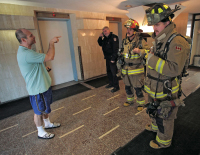
|
| Crews help R115 driver James Coones (right) clean up after a two-alarm kitchen fire in an apartment across the street from the station. |
Al Meyers (right) of Squad 313 talks with a resident of an apartment building while attending a false alarm for ringing bells. |
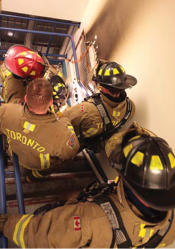 |
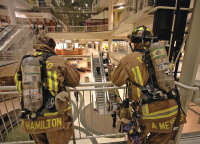
|
| Crews including squad 313 gather in the stairwell to assist in finding and extinguishing a fire behind a heater in the wall of a government building. |
S313 Captain Keith Hamilton (left) and crew member Al Meyers survey the situation after being dispatched to the Toronto Eaton Centre as part of a first-alarm response after security deployed pepper spray in the mall. |
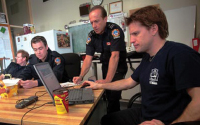 |
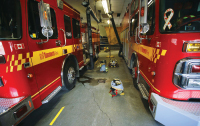
|
| Pumper 245 Acting Captain Rick Berenz (standing) helps Greg Brown do some research in designing a station crest. | Pumper and Squad 445 sit in station ready to roll. |
Station 445
My second visit was to Station 445 in Toronto’s west end, formerly the City of Etobicoke. Before amalgamation in 1998, Station 445 was home to the former city’s communications department and acted as headquarters. The district chief and the platoon chief responsible for all of west command are posted at Station 445. Similar in size and manpower to Station 313, it houses a 2004 Spartan heavy rescue and a 2002 Spartan pumper.
My assignment at this station was also on the squad. This would enable me to see what a similar truck with similar responsibilities could encounter in a seemingly quieter corner of the city. This squad typically covers highway calls on Highway 427, Highway 401 and the Gardiner Expressway/Queen Elizabeth Way combination, where car accidents requiring extrication are common. Not on my watch! After a number of false alarms during the day, a reminder of life’s quiet fragility was revealed in a medical call – a report that an elderly gentleman had fallen down in his home. Upon arrival, the crew of Squad 445 realized that this was more than a bump on the head. Immediately, they sprang into action and turned into first responders for a man in cardiac arrest. A paramedic unit quickly arrived, followed by an advanced life support paramedic. Seven trained medical responders worked relentlessly for 45 minutes but to no avail – they were not able to save him.
Firefighters don’t encounter death only in the midst of a multiple-vehicle crash or an intense building fire. They can also face it under the most ordinary circumstances and the most routine calls. Typical for a population of 2.5 million? Sadly, yes, but that’s no consolation to people who are trained to saves lives. Feeling defeated, they packed their medical bags on the truck and went back to the station knowing they weren’t able to save that man from massive heart failure. Thankfully, my day with Station 445 ended with little further action. I had experienced enough in one day to last a while.
Station 245
My next visit was with Station 245 in the east end of the city, commonlyknown as Scarborough. The single-truck station had an extremely different dynamic than the larger halls. Four firefighters working and living together in a small, cozy station is much different than sharing your space with seven or eight other people all the time.
Pumper 245, a newly delivered 2007 Spartan model, is situated in an area of the city where it sees a little bit of everything. To the north is Highway 401, with car and truck accidents and the like. Residents are older single-family homes from the 1950s and 1960s with original owners alongside new condos and apartment buildings that populate the neighbourhood in patches.
This visit started just as the truck came back from a medical call for a young , out-of-town pregnant girl having pains. The ambulance arrived and took over the call, allowing the crew to return to the station. Fire is called in a tiered system around the city where fire and ambulance are dispatched in most medical scenarios for a faster response time, accounting for the 53 per cent call rate. After a short meeting with the visiting district chief while on his rounds, I learned that Station 245 hadn’t yet offered a selection for its station emblem/patch, which was still a work in progress at the time. A couple of years ago, to boost morale and create unique identities to the amalgamated stations, Toronto Professional Fire Fighters Association Local 3888 requested that each station submit a symbolic crest that represented the station’s history or included something symbolic about each particular area of the city. Some of the selections were easy. Station 332 in the downtown entertainment district features the comedy/drama masks of the theatre. Station 325 in Toronto’s Cabbagetown district has a Cabbage Patch Kids doll in its design.
Old Scarborough and Station 245 don’t have a lot to offer in the way of landmarks or history but a couple of the guys from B shift were assigned to come up with ideas. Thankfully, there was time for this task, because reasonably quiet Station 245 was extremely quiet when I was there. An alarm-bells-ringing dispatch to a school that had already let out was the busiest it got before 8 p.m., at which time I had to leave. During my visit with Station 245, I was able to see that a small four-person station works very closely and communicates on a different level than a larger hall.
Station 115
North Command. Station 115. Rescue pumper 115 – a 1996 Spartan model in another single-truck station. Arriving the morning of Good Friday, the theme of my visits seemed to continue as the dispatch for bells ringing in a high rise came through. Rescue pumper 115 was the first to arrive. We made it to the floor in question to find that cooking odours had set off the sensitive alarms in the building. Another false alarm.
Similar to Station 245, a four-person station makes it easier to sit around the kitchen table and exchange stories than in a larger hall. This passed some time as we talked about highway calls that rescue pumper 115 had run in the past. Spending time around firefighters over the years, I have realized that reminiscing and sharing experiences tend to be therapeutic in some ways. Listening to veterans on the job describe horrific scenes of destruction that they see on a daily basis and remembering specific calls and people years later shows that not every call runs into the other. There are instances that can stick with someone throughout an entire career.
As the holiday passed without incident, dinner time approached and the preparation began. The pork roast was in the oven and the potatoes were put on to boil. If you’ve read this far, you may have noticed a pattern developing . . . Zero to 60 in three seconds.
Report of a kitchen fire in an apartment almost directly across the street from the fire station. The crew of Rescue pumper 115 barely had time to get their SCBAs on en route when we pulled into the driveway of the building. We got to the front entrance of the building and the alarms bells were ringing. A familiar sound by now, usually followed by silencing the bells, resetting the alarms and going home.
By this time, the lobby was full of people evacuating the building – a positive sign. The standard procedure for the first incoming vehicle is to take elevator control and go two floors below the fire, then ascend via stairs to other two floors. This was not possible as the weekend superintendents couldn’t find the elevator keys. While we were talking to the building manager and trying to get the elevator, the tenant from the apartment in question came running into the lobby in a panic, saying something about his kitchen on fire and that he left the suite with the flames and smoke getting worse. It was now a confirmed fire – no resetting of bells this time.
When we realized that the elevator was not an option due to the burning apartment above, the crew of three, with me in tow, located the closest stairs and made our way up six floors in a speed I never thought possible.
The smell of smoke was obvious and the requisite check was done before entering the hall. A haze of smoke was lingering in the hallway but nothing to indicate a rolling fire. A line was connected to the standpipe located next door to the apartment in question and the door to the suite was gingerly opened to examine the extent of the fire. At that point, thick black smoke was visible and the fire was described as rolling up from the stove and over the ceiling. It’s more than a pot on the stove now. A second alarm was called and the line charged – ready for a fast attack. By this time, the other first-in crews had arrived and made their way to the floor to back up rescue pumper 115. My vantage point of a civilian was safely in the stairwell, away from any danger before doors were fully opened to fight the fire. After the adrenaline rush, racing up six flights of stairs and discovering heavy smoke and fire, Captain Wallace’s first instinct was to remember that I was accompanying them and to instruct me to step into the stairwell for my own safety. Experience and calm under pressure was something that showed when it counted. Of course, he would later rub it in that “it would’ve made a pretty picture with the fire rolling up over the ceiling right before they hit it with water.”
When it was deemed safe, I was allowed into the apartment to photograph the aftermath of what started as a burning pot on the stove and eventually destroyed the whole kitchen. The family made it out safely, and thankfully, by remaining calm, did the right thing by closing the door as they left. Sadly, however, when they returned, they were faced with a smoke-damaged one-bedroom suite. Being new to the country and having no insurance, 30 seconds of leaving a pot unattended has made their lives considerably tougher. Forty-five minutes passed, the second alarm cleared and the smoke ventilated. We were the first truck in, and the last to leave.
When we got back to the hall, experience and coolness under pressure was shown once again, when it really counted . . . the oven had been turned off and the potatoes were removed from the burner before we got on the truck. Dinner was saved.
A typical day in the life of a Toronto firefighter.
John Riddell is a freelance photojournalist based in Toronto. His work can be seen at www.torontofirephotos.ca
Print this page
Advertisement
- Extrication Tips: Lifting procedures for strut systems
- From the Editor: Managing the message about fire service underfunding